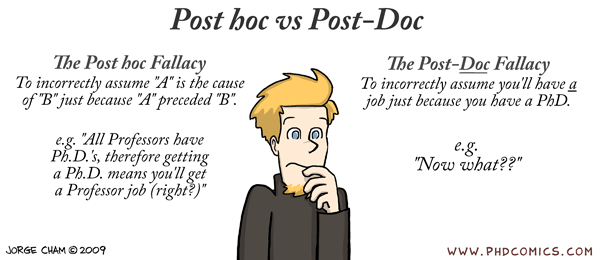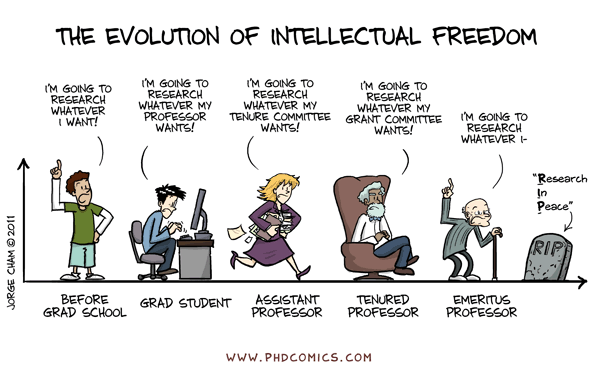Call for a Desinstitutionalized and Distributed Science

Last time I participate in a PhD selection process, I asked 10 students where did they see themselves in 10 years. The answer was unanimous: “doing research at the university”.
I got worried. It is clear to me that there won’t be positions at the university to every grad student and the fact that not even one in ten foresaw a different future, concerned me. When I discussed this with other faculty, they all agreed with the students “They have to pursue their dreams and aspirations”.
It is impressive how scientists can be irrational sometimes. Brazil is producing 16,000 PhD a year, with one of the highest increase rates in the world. However, from 2004 to 2014, we produced only 14 new universities. An article in Nature in 2010 showed a decrease of 30% in permanent tenured positions in US was accompanied by an increase in non-stable postdoc positions (Cyranoski, et al., 2011). Another article in Nature showed that US is producing around 40,000 PhDs a year but only 3,000 new positions at universities (Maher and Anfres, 2016) .
“Scientists and policymakers around the world increasingly worry about the plight of young researchers in academia, and for good reason. Competition for tenure-track positions has surged, and some early-career researchers face tough odds in the quest for funding. As a result, many see lower pay–offs for their efforts in preparing and writing grant applications. Although everyone is under pressure, those just starting out seem to feel the impacts more acutely”.
Maher and Anfres, 2016
Success rate for grants are bellow 20% in most important funders, with even lower success rates for young scientists. And across ages, most scientists have less than 40% of their time to spend on actual research. Anxiety about career perspectives is incredibly high among PhD students and influences everything: from dropouts to fraude in scientific data (De Meis et al., 2003; Levecque et al., 2017). In fact, researchers learned that money was distributed on the basis of some indexes (like number of publications and their impact factor) and started to especialize and produce theses indexes instead of knowledge. The result is that today we have the biggest credibility crisis in the history of science (Munafò et al., 2017; Begley and Ellis, 2012; Prinz et al., 2011)
It’s simple math and cristal clear that there won’t be jobs at research universities for everyone. Definitely, not for 10 out of 10 PhD candidates. In fact, an even more recent article in Nature indicates that only 3% of PhDs are likely to get a stable posting on in academia (Editorial, 2017). And even though they worry about it, they don’t have an alternative plan.
The fascination with university is understandable. They had a major role in the scientific revolution with the institutionalization of science (and… most of us had a great time when we were students).
“For most of human history, scientists were isolated people, working with limited resources, either from their own families or donated by mecenas. It was over the last 2 (now 3) centuries that science started to ‘institutionalize’: scientists were gathering in research institutes and universities around the world, that were financed by governments and industry”
Leopoldo De Meis
This passage from Leopoldo De Meis’ book (2008) in which he explains the explosion of knowledge that came after the scientific revolution. In the XVII century, there were about 150 scientists in the world and there is no estimation of the amount of knowledge (in number of scientific articles published) they produced. But it was not much, since the best library in the world, the one at Oxford University, had about 800 volumes in its ‘natural philosophy section’, the closest to what we call ‘science’ today, that a person could read in about a year, learning everything that had to be learned. In the year 1900, the estimated number of scientists in the world was 5,000 and their scientific production was published in scientific journals of wide circulation. In that specific year, 4000 articles were published (De Meis, 2008). This institutionalization of science lead to an exponential growth of scientific enterprise and In the 20th century, the number of scientists was estimated to be 30 million, publishing astonishing 2 million articles a year. The information they produced changed our way of living. We went from running with our own legs at 6.8 km.h-1 to 25 km.h-1 in ancient Mesopotamia with war chariots with 2-3 horses. It took more than a thousand years for the steam engine to reach that speed in 1925, but after that, in less than 100 years, man reached space in rockets that could reach 200.000 km.h-1 (De Meis, 2008).
But nowadays, universities are overrated. A illusion of economical importance, social status and, most of all, an illusion of intellectual freedom.

An article from 2014 in The Economist (The digital degree) may point the reason:
“Institutions’ costs are rising, owing to pricey investments in technology, teachers’ salaries and galloping administrative costs. That comes as governments conclude that they can no longer afford to subsidise universities as generously as they used to.”
The current model of science funding was established after the 2nd world war in the United States. The success of the Manhattan project as an applied science initiative, and the understanding that, ultimately, the war was won by science, lead to the perception of the strategic importance of science for a country sovereignty and the importance to create the means to continuously funding basic science that could lead to applied solutions (Bush, 1945). The model of a ministry of science and technology and a National Science Agency was copied throughout the world and until today is the mainstream. This model is also showing signals of failure, as pointed out by Donald Stokes in ‘Pasteur’s Quadrant’ (read about it here)
Is the S&T system in the whole world broken or is it a scale-up problem?
Over the last 200 year, we have reduced illiteracy world wide from about 90% in 1800 to less 15% in 2016 (Global Rise of Education). That while the population grew about 10 times. However, that doesn’t mean we can further escalate using the same processes.
I think the centralised model of research is as over as the centralised model of education, because it cannot further scale-up. We have to deinstitutionalize research to let it scale-up.
And when I say deinstitutionalize, I’m not saying to move to big companies with large R&D budgets. There aren’t enough of those either. It is time for scientists to become entrepreneurs. It is (likely to be) the only way we will be able to cope with the increasing amount of scientists in the world.
Internet gave us the opportunity to connect in an unprecedented manner. New media allowed us to regain authorship. Social networks allowed us to crowdfund, crowdwork and crowdsource ideas, projects and businesses. Now, blockchain let us bring full transparency to initiatives, at the same time they retain privacy and data security; as well as give us the means to finance this new models with cryptocurrencies. All in a distributed manner.
So far, most have been expectators in the blockchain movement. But we want to be part of it and we want to use the power of this new technology to foster crowdscience and entrepreneurship.
Posted originally in 2018 on Linkedin









Recent Comments
Bernardo MonteiroSays
One little step further and you would be to be to talk to future versions of you, to help you…
Euclydes SantosSays
"Tristo è quel discepolo che non avanza il suo maestro" Orgulho de te ver voando alto e fugindo com folga…